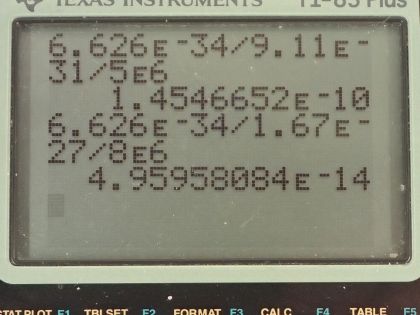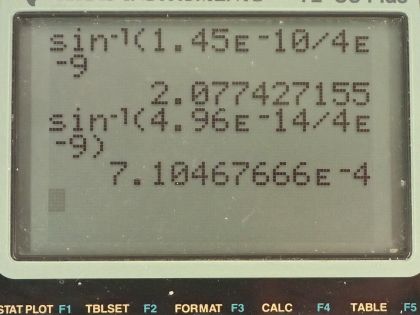Question
Using the definition of the de Broglie wavelength, explain how wavelike properties of matter increase with a decrease in mass or decrease in speed. Use as examples an electron (mass = ) with a speed of and a proton (mass = ) with a speed of .
Final Answer
Compare the angle to the first order maximum if each wave were used in a double slit experiment:
The angle for the electron would be easily measurable - the electron would show wavelike properties for matter given a small mass. The angle for the proton is not easily measurable - the "interference pattern" would be so condensed over such a small angle that it would be indistinguishable from a single spot, so it would not appear to show wavelike properties.
Solution video
OpenStax College Physics for AP® Courses, Chapter 29, Problem 14 (Test Prep for AP® Courses)

vote with a rating of
votes with an average rating of
.
Calculator Screenshots
Video Transcript
This is College Physics Answers with Shaun Dychko. We want to know the maximum velocity of electrons ejected from a material by 80 nanometer photons given a binding energy of 4.73 electron volts. Now we have an expression for kinetic energy of the electron so we'll figure that out first and then we will substitute one-half mass times velocity squared in place of kinetic energy and solve for v. Okay! So kinetic energy is the total energy of the photon, which is Planck's constant times its frequency minus the binding energy. Well we are given the wavelength of the photon so we better substitute for f in terms of λ. The wave equation tells us that the speed of light equals a product of the wavelength and the frequency and we'll divide both sides by the wavelength to solve for frequency. So frequency is speed of light divided by λ and we'll substitute that in for f, which we do here. Now we have another expression for kinetic energy of the electron, which is one-half times the electron's mass times its velocity squared so we will substitute that in place of kinetic energy here and then multiply both sides by 2 over mass of the electron and then we get this expression take the square root of both sides to solve for the velocity and so the speed of this electron then is the square root of 2 over the mass of the electron times Planck's constant times speed of light divided by the wavelength minus the binding energy. Now since we have a kilogram unit here that sort of informs what units we have to use for Planck's constant; often when I see hc together I like to use 1240 electron volt nanometers— that's often a good choice for convenience— but in this case because we are mixing with kilograms, we need to use mks units—meters, kilograms and seconds. So we have 2 divided by 9.11 times 10 to the minus 31 kilograms— that's the mass of the electron— times 6.626 times 10 to the minus 34 joule seconds— Planck's constant— times the speed of light divided by the wavelength in meters so that's 80 times 10 to the minus 9 meters minus 4.73 electron volts converted into joules because joules is an mks unit so we multiply by 1.602 times 10 to the minus 19 joules for every electron volt and this works out to 1.95 times 10 to the 6 meters per second.

